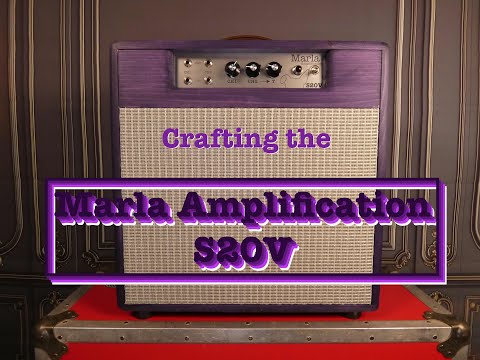Marla Amplification
Marla S20V 2Channel 22Watt Combo
Marla S20V 2Channel 22Watt Combo
Couldn't load pickup availability
Technical Info
Input Voltage: 120V
Ohm Rating: 8ohm
Power Output: ~22 Watts
Inputs: Channel 1 - High & Low Sensitivity
Channel 2 - High & Low Sensitivity
Controls: Channel 1 Volume, Channel 2 Volume, Channel 2 Tone
Tubes: (2) 12AX7, (2)6V6GT, GZ34
Speaker: Mojotone 25w British Invasion 8ohm
Weight: ~36lbs Unboxed, ~38lbs Boxed
Dimensions: 20” x 20” x 9”
Raw Materials Used:
Orange Drop 715 Series, Sozo NexGen Yellow Mustard &
Sozo NexGen Blue Molded Coupling Caps
Metal Film and Metal Oxide resistors
Mojotone KingCap Filtering Caps
Hammond 290 Series Power Transformer
Hammond 1750 Series Output Transfomer
Switchcraft Jacks
Alpha Pots
Marla Speaker Cabs and Chassis are also Made in North Carolina
Voicing
The Marla Amplification S20V is my take on all the best Tweed Era sounds compacted down into one gig worthy combo. At first glance the S20V looks much like the tweed dlx; This makes the amp approachable to fans of early American amps, but that is far from its tonal foundation. There is much more headroom and drastically less compression at low volumes than the deluxe. The S20V is equipped with two channels, both having low & high sensitivity inputs, meant to give players a wide
variety of jumping off points for their signature sound. The two channels are independent in voicing and signal path, so they need to be jumped with an ABY or Jumper Cable if you would like to blend both worlds. Jumping the two channels will create a sensational amount of midrange overdrive and top end sizzlely distortion. Coming in under 36lbs, the Marla S20V is one of the lightest weight ~20 watt combos on the market.
Channel One
Bright & Bassy, with a loose feel that reminds me of a 5D5 Pro Amp mixed with a 59’ 5F6-A bright channel. Channel one has the same extended low pass cut off as a typical Bassman, but when paired with the 12in Greenback style speaker, it gains an enhanced amount of low end; much like a 5D5 Pro Amp. A modest bright cab (value sits between the common Fender and Marshall Caps) softly adds in some extra crispiness for cut and clarity. This is a great channel for single coils and rhythm playing.
Channel Two
Tight & Narrow with a dedicated tone pot. This channel is voiced much like a Princeton, with a wider-than-average tone sweep that can cut out well beyond just the typical amount of high-end frequencies, giving players increased control over their sound. This channel is great for sparkly cleans, humbuckers, and sculpting lead tones.
Speaker
The Mojotone 12in British Invasion was an easy choice to pair with the S20V. The lower power handling that almost matches the output wattage was meant to encourage pushing the speaker near its limits. This gives the amp that 70’s fuzz rock feel when cranked and makes the amp sound larger than it looks. In my opinion, the Mojotone British Invasion also balances all frequencies evenly at all volumes and doesn’t “come to life” after a certain volume. This makes life easy when mixing in the studio or on stage.
Tube Layout
The S20V ships with a pair of JJ 12AX7’s for the Pre-Amp and Phase Inverter. The power section hosts two JJ Electronics 6V6GT tubes, that are fixed biased, supporting the theme of plug and play for musicians. The S20V ships with a JJ Electronics GZ34 rectifier tube, giving players access to high plate voltages and low SAG. If players would like a tamer sound and less top end hair on the overdrive, then a 5URGB will drop the voltages, creating a more modern and compressed sound without losing any notable power.
Cabinet
The S20V sports a 20”x20”x9” solid pine cab with a 5/8 semi open back baffle. The oversized cab produces a robust low end, the solid pine keeps top end pronounced and the semi open back contributes to the feel of notes being more resonant than anticipated. This amp is hand stained with a Polyurethane finish to limit normal ware from the elements. Additionally, if you’re in the studio, mic the speaker from the front and from the back – it’s a cool trick from the 70s and hearing a mix of cab and speaker cone makes the recording sound like a freight train!
Share

























